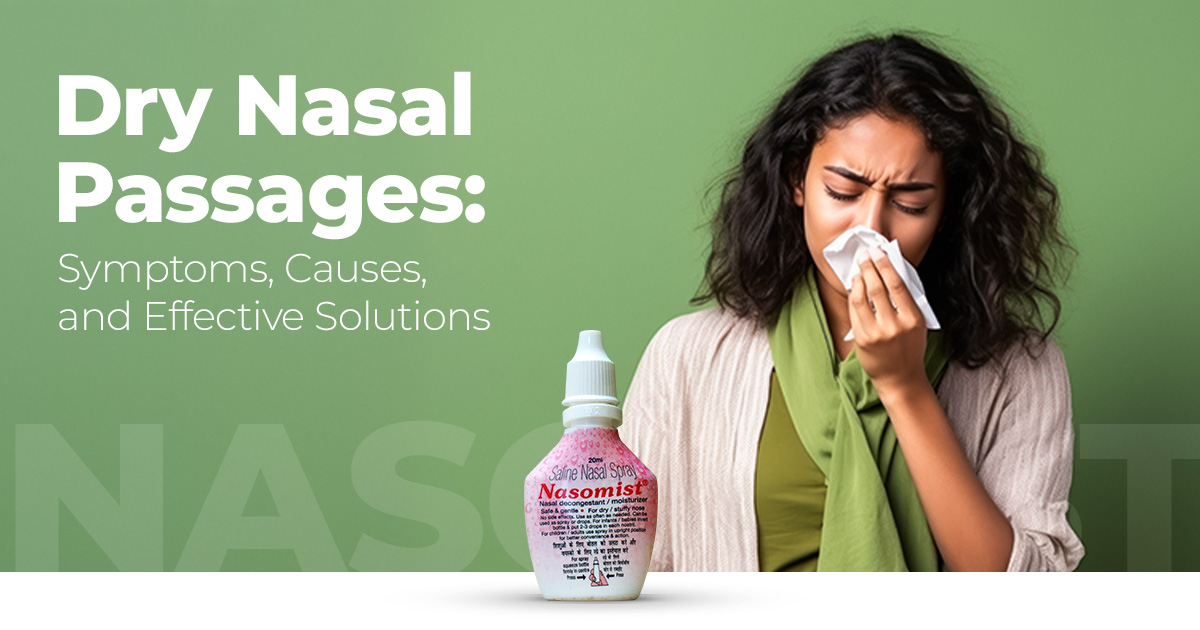Dry Nasal Passages: Symptoms, Causes, and Effective Solutions
Date Created: 28 Feb 2025

Introduction
Nasal mucosa, when properly hydrated, acts as the first line of defence against allergens and pathogens. When the moist lining inside the nose becomes dry it can result in an uncomfortable and painful condition known as dry nasal passages.
Dry nasal passage or dry nose is also known as Rhinitis sicca. It is a frequent pathology affecting numerous people around the world, often caused due to allergies or infections of the upper respiratory tract.
Chronic nasal dryness can compromise the barrier, leading to irritation, inflammation, and an increased risk of infections of the respiratory tract.
By understanding the symptoms and causes, individuals can take proactive steps toward relief from dry nasal passages.
This blog will give an overall clinical insight into the symptoms, causes, complications and effective solutions for treating dry nasal passages.
Understanding Dry Nasal Passages
Dry nose symptoms:
Dry nasal passages can cause numerous symptoms which can be varied. The general clinical manifestations of dry nasal passages include:
- Persistent dryness or irritation of the nasal mucosa
- Formation of crusts or scabs within the nasal cavity
- Recurrent epistaxis (nosebleeds) due to mucosal fragility
- Nasal congestion without mucus
- Sore throat
- Headaches with facial pain
- Reduced mucous clearance, leading to impaired nasal function
A dry nose can cause further health complications if not addressed properly.
Causes
The following factors are commonly associated with dry nasal passages:
There are several factors which can contribute to nasal dryness.
- Environmental Factors:
- Dry air and low ambient humidity, especially in dry winter months.
- Prolonged exposure to air conditioning or heating systems can make the atmosphere dry.
- Pathophysiological Conditions:
- Atrophic rhinitis: Progressive thinning and drying of the nasal mucosa.
- Chronic sinusitis: Altered mucus production and mucosal inflammation along with associated allergic reactions.
- Pharmacological Influences:
- Antihistamines and medicated decongestant sprays can cause rebound dryness in the nasal mucosa.
- Lifestyle and External Irritants:
- Smoking and exposure to pollutants.
- Insufficient fluid intake.
- Excessive intake of caffeine, alcohol, and salt can cause the mucous membrane to dry out.
- Ageing:
- Degeneration of nasal glandular tissue reduces mucus production with age.
- Postmenopausal women experience dryness of the moist membranes.
- Underlying Health Issues:
- Conditions such as Sjogren’s syndrome may impair moisture production.
Potential Complications
If untreated, chronic dry nasal passages may result in complications which require immediate medical assistance.
- Increased risk of respiratory infections.
- Frequent nosebleeds due to irritation.
- Disturbed sleep patterns due to compromised breathing.
How to treat a dry nose
Natural and Lifestyle Remedies
- Humidifying the environment- Humidifiers can replace the moisture lost due to air conditioning and central heating in homes and offices. Maintaining optimal humidity levels using a humidifier can be an effective strategy to prevent nosebleeds.
- Steam inhalation- Inhaling steam from hot water can help add moisture directly into your airways. Steam can also be inhaled from showers or sauna baths.
- Nasal saline medications- Using over-the-counter nasal sprays, drops, or saline gels. Using nasal saline sprays offers an excellent solution for moisturizing dry nasal tissues.
- Hydration is the key- Staying hydrated by drinking plenty of fluids throughout the day.
- Avoiding nonessential medications- Stop using medications that may dry out the sinuses as a side effect.
- Toxin exposure- Limiting exposure to toxins like smoke and other pollutants.
- Moisturize externally- Applying a gentle moisturizer around the nostrils helps alleviate irritation. Using coconut oil or petroleum jelly can be useful.
- Avoid smoking and vaping- Irritation from tobacco smoke can further irritate the nasal mucosa causing dryness and crust formation.
- Reducing alcohol consumption- Alcohol acts as a diuretic and the body tends to lose more water content when it is consumed.
Saline nasal sprays
Saline nasal sprays are a cornerstone for dry nose relief due to their safety and efficacy.
Nasomist is India’s first nasal saline solution, trusted by the medical community for over 25 years.
It has the following benefits:
- Unlike stronger decongestants, saline nasal sprays like Nasomist, does not cause rebound congestion or any side-effects.
- Regular use hydrates the mucosa, preventing crusting and irritation.
- The buffered saline solution enhances mucous clearance while hydrating the nasal passages effectively.
- Restoring the normal pH of the nasal cavity.
- Providing hydration without any adverse effects is ideal for frequent use across all age groups.
It is an effective solution for blocked noses, rhinitis, sinusitis, and other nasal conditions. Its dual functionality as a spray and drop makes it convenient for all ages, from infants to adults.
Conclusion
Dry nasal passages are not just uncomfortable; they can lead to more serious health issues if neglected. Understanding their symptoms and causes is of utmost importance to avoid any further complications.
Utilising natural remedies like humidification of the environment, steam inhalation and proper hydration along with lifestyle modifications allows prolonged relief.
Using nasal saline sprays play an important role in maintaining nasal health. They offer safe, effective relief without any side effects.
Consultation with a healthcare professional becomes necessary when the symptoms of nasal dryness and nose bleeding persist or worsen.
Understanding and addressing the underlying causes of dry nasal passages can improve respiratory comfort and reduce the risk of more severe conditions related to the upper respiratory tract.
Recent Posts

Iron Deficiency: Symptoms, Causes and Treatment
Read More...
What is indigestion? All You Need To Know
Read More...

